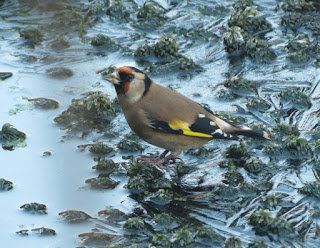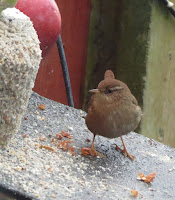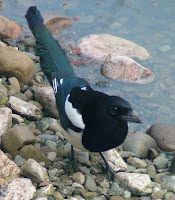 |
| Goldfinch on frozen pond - L Bimson |
 |
| Coal tit - L Bimson |
The event held over the last weekend in January revealed an increase in sightings of smaller birds, such as goldfinches, long-tailed tits and coal tits that can usually be seen visiting gardens and outside spaces in mixed flocks. Recorded sightings of the brightly coloured, sociable finch rose by 17% on 2017 figures for Merseyside and its bright red face was seen in more than a third of gardens. Other small birds that are thought to have benefited from the mild January weather include long-tailed tits (+20%) and coal tits (+7%).
It also proved to be a good year for the greenfinch after a 4% rise in numbers seen, a welcome sign for a species that has undergone a 60% decline in sightings since the first survey in 1979.
The influx of these species to our gardens is thought to be linked to the favourable conditions during their successful breeding season in 2017. This, combined with the kind autumn and early winter weather in the run up to the Birdwatch in January, will have contributed to the rise in sightings.
Daniel Hayhow, RSPB Conservation Scientist, said: “Our garden birds are a part of our everyday life, whether it’s the robin perched on the garden fence or the flock of starlings you see on your way to work. To have hundreds of thousands of people spend an hour watching the wildlife in their garden isn’t only great to see, but it also helps us build up a picture of how our garden birds are doing, which is really helpful.
“Last summer was a really good year for many breeding birds with warm weather creating great conditions for many smaller birds to raise their young to adulthood. The rise in sightings of goldfinches, long-tailed tits and coal tits, along with chaffinches and greenfinches nationally, goes to show that in the absence of cold weather they can survive the winter months in good numbers. Looking at the results it is likely that across the UK this is what people saw in their garden.”
 |
| Wren - L Bimson |
year.”
 |
| House sparrows - L Bimson |
The house sparrow remained at the top of the Big Garden Birdwatch rankings as the most commonly seen garden birds with an average of more than three per garden recorded in Merseyside throughout the weekend. Starling held down the second spot, with the blackbird rounding off the top three.
 |
| Magpie - L Bimson |
For a full round up of all the RSPB Big Garden Birdwatch results and to see which birds were visiting gardens where you live, visit www.rspb.org.uk/birdwatch
The top 10 birds in 2018 RSPB Big Garden
Birdwatch for Merseyside:
Rank
|
Species
|
Change in rank 2017-2018
|
Average per garden
|
Average per garden% change 2017 - 2018
|
% of gardens species recorded in 2018
|
% of gardens species recorded in change 2017-2018
|
1
|
House sparrow
|
0
|
3.2
|
0
|
52
|
-4
|
2
|
Starling
|
+1
|
2.5
|
-8.3
|
32
|
-12
|
3
|
Blackbird
|
-1
|
2..4
|
-12.1
|
88
|
-4
|
4
|
Woodpigeon
|
0
|
2.2
|
-7
|
79
|
-3
|
5
|
Goldfinch
|
+1
|
2.1
|
+17.3
|
34
|
0
|
6
|
Blue tit
|
-1
|
2.0
|
-6
|
70
|
-5
|
7
|
Magpie
|
0
|
1.7
|
-2.1
|
66
|
0
|
8
|
Robin
|
0
|
1.3
|
-12
|
80
|
-7
|
9
|
Great tit
|
0
|
1.3
|
-3.3
|
52
|
-3
|
10
|
Feral Pigeon
|
0
|
1.1
|
-6.8
|
25
|
-3
|
3. Selected other results from RSPB Big Garden Birdwatch for Merseyside:
Rank
|
Species
|
Change in rank 2017-2018
|
Average per garden
|
Average per garden% change 2017 - 2018
|
% of gardens species recorded in 2018
|
% of gardens species recorded in change 2017-2018
|
14
|
Chaffinch
|
0
|
0.7
|
+11.2
|
27
|
+6
|
15
|
Coal tit
|
0
|
0.5
|
+6.7
|
28
|
+8
|
16
|
Greenfinch
|
+2
|
0.4
|
+4
|
16
|
-1
|
4. The top 10 birds in 2018 RSPB Big Schools Birdwatch for Merseyside
Rank
|
Species
|
Change in rank 2017-2018
|
Average per garden
|
Average per garden% change 2017 - 2018
|
% of gardens species recorded in 2018
|
% of gardens species recorded in change 2017-2018
|
1
|
Magpie
|
+3
|
7.0
|
+40.8
|
82
|
+6
|
2
|
Black headed
gull
|
-1
|
5.8
|
-47.5
|
47
|
-7
|
3
|
Blackbird
|
0
|
5.1
|
-0.3
|
67
|
-14
|
4
|
Feral pigeon
|
+2
|
4.9
|
+86.3
|
68
|
+39
|
5
|
Woodpigeon
|
-3
|
4.2
|
-29.9
|
71
|
-2
|
6
|
Common gull
|
+13
|
3.2
|
+579.4
|
36
|
+291
|
7
|
Carrion crow
|
+7
|
2.3
|
+105.1
|
53
|
+68
|
8
|
Herring gull
|
+2
|
1.7
|
-18.5
|
27
|
-35
|
9
|
Blue tit
|
+3
|
1.5
|
-0.9
|
47
|
-14
|
10
|
Robin
|
-3
|
1.4
|
-44.9
|
53
|
-16
|
Laura
